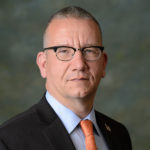Mentorship
The Mentorship Program creates one-on-one partnerships between graduate students and postdocs and professional EBRC members from industry, nonprofits, and government.
Mentoring can have great benefits for helping early career scientist navigate their journey from student to professional. For students in engineering biology labs, in particular, mentoring programs in which students are paired with industry or government professionals can provide valuable new perspectives, especially for those considering career paths outside academia. The EBRC Mentorship Program establishes 1:1 partnerships between graduate students and postdocs in engineering biology and related fields and professional EBRC members from industry, non-government associations and nonprofits, and government.
How the Mentorship Program works:
Only graduate students and postdocs in EBRC member labs are eligible to apply as a Mentee for the program. Mentoring partnerships are designed to last 12 months, with new mentoring partnerships formed each winter and introduced during a kick-off event at the Spring EBRC Retreat. A student/postdoc is allowed only one Mentor. Scientists and leaders from EBRC companies and organizations are eligible to become Mentors. There is no limit to the number of Mentors per company, but the Program aims to have as many companies and organizations involved as possible, to represent the breadth of the community. The commitment to the program is for one year at a time.
For more information on the application process and establishing the Mentor-Mentee partnership, please see the mentorship program details.
2022 Mentors
Mentor Cohort: 23 of 26 mentors*
*Not all mentors have elected to be featured
-
Emily Aurand
Director of Roadmapping and Education
Full Bio →
-
James Diggans
Twist Bioscience Corporation
Full Bio →
-
John Dileo
MITRE
Full Bio →
-
Matthew Downs
MITRE
Full Bio →
-
Steven Evans
BioMADE
Full Bio →
-
Mike Fero
TeselaGen Biotechnology, Inc.
Full Bio →
-
Clem Fortman
BioMADE
Full Bio →
-
Stephen Gasior
Corteva Agriscience
Full Bio →
-
Natalie Gogotsi
Lockheed Martin
Full Bio →
-
Chad Haynes
LanzaTech
Full Bio →
-
Lauren Junker
BASF
Full Bio →
-
Caroline Kennedy
MITRE
Full Bio →
-
Tim Kilgore
MITRE
Full Bio →
-
Becky Mackelprang
Director for Security Programs
Full Bio →
-
Oliver May
DSM
Full Bio →
-
Nigel Mouncey
Joint Genome Institute
Full Bio →
-
Rebecca Nugent
Full Bio →
-
David Shepherd
Department of Homeland Security
Full Bio →
-
Jeffrey Stuart
Lockheed Martin
Full Bio →
-
Ryan Tappel
LanzaTech
Full Bio →
-
Tom Tubon
BioMADE
Full Bio →
-
Elizabeth Vitalis
BioMADE
Full Bio →
-
Adam Woomer
Lockheed Martin
Full Bio →
Mentorship Program Details
What mentoring is:
A dedicated partnership between a student and an industry or government professional, designed to support and guide students as they develop as scientists and consider a variety of career paths
What mentoring is not:
A job search or recruiting tool.
A source of technical advice.
A replacement for the partnership between a student and his/her faculty advisor.
- The application period for the EBRC Mentorship Program is announced each year via email to the EBRC Student & Postdoc Association (SPA) membership listserv.
- Applicants to the Program are provided with a list of participating Mentors, generated by solicitation to the EBRC membership, and asked to indicate their interest in particular Mentors based on provided biographies.
- After application submissions in January and early February, the SPA selects the top Mentee candidates based on their year in graduate school/postdoctoral research (preference for later years), geographical location, and ranked order of mentor preferences. Matching the Mentor with the Mentee will be done by a SPA Mentorship Liaison, with the goal of enabling the Mentee to select his/her Mentor. This matching can be facilitated via a prospective Mentor-Mentee meet-up at the Spring EBRC Retreat, which participants in the program are expected to attend.
- Once a Mentor-Mentee partnership has been established, both parties agree to a one-year commitment to the program. This relationship can be maintained in succeeding years or, at the request of either the Mentor or the Mentee, can be terminated with the establishment of new Mentor-Mentee pairs in the new cycle.
- It is the responsibility of the Mentee to make the initial contact with his/her Mentor. If contact cannot be made, the Mentee will notify the Mentorship Liaison, who will attempt to contact the Mentor. If there is no response, the Mentorship Liaison, in concert with the Mentee, will attempt to find another Mentor.
- When the Mentor and Mentee first meet they should discuss frequency and type of meetings (phone calls, in person, etc.). The Mentee should communicate what he or she is looking for from the Mentor and the Mentor should inform the Mentee of other topics and activities that could be of interest to them. For maximum benefit, it is important that Mentor and Mentee understand each other’s expectations.
- If the Mentor and Mentee cannot reach agreement on the nature of the relationship, the Mentorship Liaison should be contacted by the Mentee and Mentor. Every effort will then be made to find another Mentor. Similarly, if an issue arises in encounters between Mentor and Mentee or in the program, the Mentorship Liaison should be notified.
- Although there is no requirement for numbers and duration of contacts, Mentors and Mentees are encouraged to interact at least once per month. If possible, in-person meetings can take place at EBRC Retreats and other events.
- After three months, the Mentorship Liaison shall inquire, via a brief email questionnaire, as to how each Mentor-Mentee relationship is working. This will allow the SPA to catch any issues that were not previously reported.
- A final questionnaire at the end of the program will be sent to Mentees and Mentors, who are expected to complete it.





















